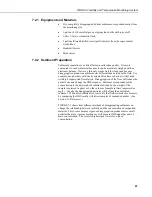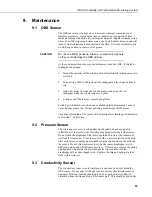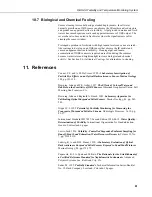
OBS-3A Turbidity and Temperature Monitoring System
10.6 Bubbles
Although bubbles efficiently scatter IR, monitoring in most natural
environments shows that OBS signals are not strongly affected by bubbles.
Bubbles and quartz particles backscatter nearly the same amount of light to
within a factor of approximately four, but most of the time bubble
concentrations are at least two orders of magnitude less than sand
concentrations in most environments. This means that sand will produce much
more backscatter than bubbles in most situations and bubble interference will
not be significant.
The scattering intensity of mineral particles, bubbles, and suspended organic
material are shown in FIGURE 10-5. OBS sensors detect IR backscattered
between 140° and 160°, and where the scattering intensities are nearly constant
with the scattering angle. Particle concentration has the most important effect
in this region. OBS sensors are also more sensitive to mineral particles than
either bubbles or particulate organic matter by factors of four to six. In most
environments, interference from these materials can therefore be ignored. One
notable exception is where biological productivity is high and sediment
production from rivers and resuspension is low. In such an environment, OBS
signals can come predominately from plankton. Prop wash from ships and
small, clear mountain streams where aeration produces high bubble
concentrations are another probable source of erroneous turbidity readings.
0
20
40
60
80
100
120
140
160
180
Scattering Angle (
θ
)
0.001
0.010
0.100
1.000
10.000
Scat
te
rin
g In
te
nsi
ty
Organic Material
Minerals
OBS
Backscatter (90 - 180o)
θ
Bubbles
FIGURE 10-5. Scattering intensity vs. angle
60



















